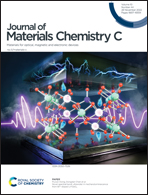Theoretical insights into single-pole quadruple-throw (SP4T) inorganic nonlinear optics molecular switch of Na(HCN)3Na: from superalkali to superalkalides†
Abstract
Seeking novel multi-response molecular switches have led to the ongoing development in the field of molecular electronics. Focusing on single-pole quadruple-throw (SP4T) nonlinear optics (NLO) molecular switch with alkalide and electride's characteristics, Na(HCN)3Na is theoretically constructed with two doped sodium atoms and three hydrogen cyanides. It has been found that the oriented external electric field can drive excess electrons to transfer from one Na atom to another. Subsequently, the electride-like superalkali Na(HCN)3Na (D3h, off form) with zero dipole moment and very small static first hyperpolarizability (βe0) switches into four superalkalides (C3v, on forms) with considerably large ones. The increases in βe0 values from off to on forms constitute a 2–3 orders of magnitude. These large differences between them indicate that Na(HCN)3Na is a high-performance candidate for SP4T NLO switch.



 Please wait while we load your content...
Please wait while we load your content...